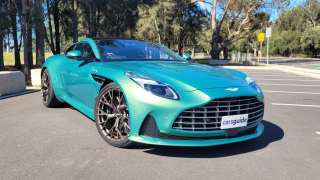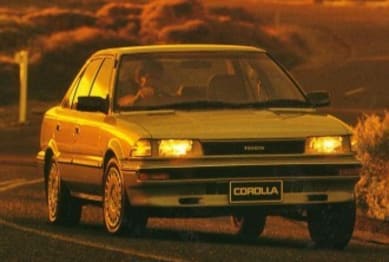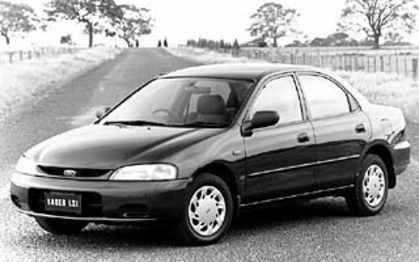
Used Toyota Corolla review: 1989-1994
- Toyota Corolla
- Toyota Corolla 1989
- Toyota Corolla 1990
- Toyota Corolla 1991
- Toyota Corolla 1992
- Toyota Corolla 1993
- Toyota Corolla 1994
- Toyota Corolla Reviews
- Toyota Reviews
- Toyota Hatchback Range
- Toyota Sedan Range
- Toyota Wagon Range
- Hatchback
- Sedan
- Wagon
- Toyota
- Used Car Reviews

What we like
- Cheap
- Reliable
- Available in a range of bodystyles
What we don't
- Not at all safe by today's standards
- Low on features, even options
- Timing belt and transmission fluids need to be changed
What we like
- Cheap
- Reliable
- Available in a range of bodystyles
What we don't
- Not at all safe by today's standards
- Low on features, even options
- Timing belt and transmission fluids need to be changed
As the new AE90 series Toyota Corolla was entering the market in the late-1980s the small car was beginning a transformation that would see it move from being cheap and cheerful transport for the impoverished to a car with a much broader appeal.
It would be some years before the transformation was complete as we see it today, but the small car was no longer dismissed by those rusted on to traditional mainstream six-cylinder models.
While they were still regarded as cars for the hard-up or second family cars for the wife or the kids in the family, change was on the way.
Compared to the previous model the new AE90 series was wider, heavier, quieter, and smoother riding. All round it had less of the tinny feel that gave small cars their cheap feel.
Models
The model range Toyota offered with the AE90 series was massive with more than 20 choices of four-door sedans, five-door hatchbacks, longer five-door SECA liftbacks, and wagons.
Most were built in Australia, but some, like the wagons and SECA liftbacks were imported from Japan.
The entry model was the SE, available as a sedan or hatch, and powered by a 1.4-litre engine until an upgrade in 1991 when it the 1.4 was replaced by the 1.6-litre carburettor unit with more horsepower and torque.
It was fairly basic model with only remote releases for the boot/hatch and fuel filler cap, and a radio-cassette player for standard equipment.

You could have air conditioning, but that was an extra cost option, and it wasn’t climate control.
The CS was the next step up in the range. It too was available as a sedan or hatch, with power from the 1.6-litre engine.
Like the SE the list of standard equipment on the CS was limited. You got the same remote releases for the boot/hatch and the fuel filler, but you could have power steering as well as air conditioning if you were prepared to pay extra.
The CS became the CSi in the 1991 upgrade; the biggest change was under the bonnet where the engine was upgraded to a 1.6-litre fuel-injected engine.
Further up the model range was the CSX, which had the extra performance of the 1.6-litre engine and came with standard power steering, four-speaker stereo sound for the radio-cassette, a tachometer, central locking, body-coloured bumpers as well as the remote releases for the boot/hatch and fuel filler cap. As with the other models air conditioning was optional.
The CSX badge was dropped in the 1991 update and henceforth it was called the Ultima. At the same time it too got the 1.6-litre fuel-injected engine.
At the top of the range was the SX, which was available as a sedan or SECA liftback and powered by a 1.6-litre fuel-injected four-cylinder engine imported from Japan.
Befitting its place atop the tree the SX came with much more standard equipment, including alloy wheels, leather steering wheel and gear knob, tilt-adjustable steering column, power door mirrors, front and rear spoilers, sports instruments, and four-wheel disc brakes.
Unfortunately air conditioning was still an optional extra, as was power steering.
Like the other models in the range the SX also got a new badge in the 1991 update when it became the GTi.
Wagon versions of the Corolla were all imported from Japan and all had four-wheel drive.

Designed long before the arrival of the digital age the AE90 series had none of the features of today’s cars. There was no sat nav, no Bluetooth to connect your iPhone or Android device, and no touch screen.
Rear parking sensors, reversing cameras or park assist hadn’t yet been conceived, parking tended to be more tap-and-go.
It’s hard to believe, but there wasn’t even a single cupholder.
You couldn’t have a sunroof either; AE90 owners weren’t considered flush enough to justify offering one, even as an option.
Cabin
Inside, the Corolla was basic but comfortable, the dash was logically laid out and easy to use.
The driver and front passenger sat on new seats with larger cushions and more substantial side bolsters for greater support.
Front leg and headroom was typical of the small car class, but sufficient for most adults.
Those in the rear weren’t so fortunate and had to endure limited legroom, particularly with the front seats adjusted back.
While the Corolla was rated for five the rear seat was really only suitable for kids.
On the positive side the boot was quite generous for a small car. It was even more so in the sedan, which with its 60/40 split/fold rear seat could take considerable more luggage.
Engine
All engines in the AE90 range were free-revving twin-cam units; they were all petrol (no diesel) engines.
Most models were powered by the locally produced 1.4-litre or 1.6-litre engines, which had carburettors, while the imported SX and the wagons boasted 1.6-litre engines with fuel injection.
That changed in 1991 when the 1.4-litre engine was dropped. The SE then got the 1.6-litre carburettor engine and the other models were upgraded to fuel-injected 1.6-litre engines.
A five-speed manual gearbox was standard at the launch with a three-speed auto option, but a much more usable four-speed auto was introduced on all models except the SE in the 1991.
Driving
The AE90 was an easy car to drive, handle and park, but without power assistance the steering was a little on the heavy side, particularly at slow speeds.
Performance, while not scintillating, was lively and energetic, and things improved after the switch to fuel-injected engines in 1991.
With front-wheel drive the handling tended towards the safety of understeer when pushed.
More attention was paid to road noise in the AE90, but it’s still quite high compared to a car today.
Safety
The electronic age in car design hadn’t yet dawned and the AE90 had none of the safety features that came with it.
There were no airbags, not even as options, and it didn’t have ABS braking, let alone Electronic Brakeforce Distribution, Emergency Brake Assist, Traction Control, and Electronic Stability Control that we expect to see on even the most basic of models today.
Likewise it was much too early for ISOFIX baby car seat restraint location points, which didn't become legal in Australia until 2014.
The idea of buying one for the wife or kids doesn’t bear thinking about.
ANCAP doesn’t provide a rating for the AE90 Corolla, but it’s safe to say that it wouldn’t meet even the basic requirements to qualify for one if it were being tested today.
Any common issues
Although the AE90 was a well-designed, well-built and reliable car in its day, buying one now is a risky proposition (with no warranty) and not recommended without careful consideration.
With the earliest examples having been on the road for more than 25 years you have to expect even the best of them to be close to the end of the road and the wrecker’s yard.
A number of owners who responded to our call for comments told us their cars are still going strong even thought they have done in excess of 200,000 km.
While that should give buyers a degree of confidence to purchase it doesn’t diminish the need to thoroughly check these cars before handing over any cash.
The key is to buy on condition, low kilometres and a full service history.
There was no capped-price servicing when the AE90 came on the scene, but servicing the Corolla is simple and inexpensive. Even so some owners skip services for many and varied reasons, often financial, so if a car doesn’t have a credible service record be suspicious.
Toyota recommended servicing the Corolla every six months of 10,000 km and the need to maintain that routine hasn’t changed. If anything it is now even more important, so that things needing attention due to wear or impending failure can be addressed before they become problems.
The AE90 engines use a timing belt (not timing chain) for driving the camshafts and that needs to be changed every 150,000 km.
It’s also important to check the automatic transmission. The AE90 was built before the arrival of automatics that are filled with oil when they’re built and don’t need any further checking, the AE90 transmissions do need checking and topping up with oil as needed, and they operate at their best if they’re regularly serviced.
Test-driving an old car like the AE90 Corolla is more critical than it is with a newer car, there are more things likely to be identified.
Look for smoke from the tailpipe, which could indicate a worn-out engine, check for oil leaks, make sure the auto transmission changes gears smoothly and without hesitation, and listen for knocks and clunks in the suspension and steering that could indicate work bushes of CV joints.
Inside, look for worn or torn trim, broken or warped plastic fittings, and make sure all of the electrical systems are working.
Also look carefully for evidence of a crash; the chances of a car being involved in a crash in almost 30 years on the road are very high.
Owners’ views
Emma Harrison: I’ve driven my 1991 Corolla CSi for five years and it’s been very reliable, cheap on service costs and economical
Joe Stafford: My 1991 Corolla CSi now looks dated, but is smooth, quiet, rattle-free, and good to drive. Perfect if you’re on a tight budget.
Billy Weslake: My 1992 SE was my first car and I’ve owned it for over five years. In that time it’s been cheap and dependable, all you need in a car.
Damien Forster: I have a 1991 Corolla CSX Seca, which is economical, handles well and is easy to drive, even after 200,000 km.
Lisa Broad: I’ve had my 1993 Corolla Seca for 13 years; it’s done over 250,000 km and is still going strong. It’s got lots of space, is economical and eats up the highway. I don’t like the grey interior, and I’d like a cup holder, but they're minor gripes against the reliability and practicality.
Verdict
Cheap and reliable alternative to a bus ticket.
Have you owned a Toyota Corolla before? Let us know your experience in the comments below.
Pricing
| Year | Price From | Price To |
|---|---|---|
| 1994 | $1,980 | $4,070 |
| 1993 | $1,980 | $4,070 |
| 1992 | $1,380 | $4,070 |
| 1991 | $1,380 | $4,070 |
| 1990 | $1,380 | $4,070 |
| 1989 | $1,380 | $4,070 |
Pricing guides
Range and Specs
| Vehicle | Specs | Price* | |
|---|---|---|---|
| CS | 1.6L, Leaded, 5 SP MAN | $1,380 – 2,200 | 1989 Toyota Corolla 1989 CS Pricing and Specs |
| CS | 1.6L, Leaded, 5 SP MAN | $1,380 – 2,200 | 1989 Toyota Corolla 1989 CS Pricing and Specs |
| CS-X | 1.6L, Leaded, 5 SP MAN | $1,980 – 3,080 | 1989 Toyota Corolla 1989 CS-X Pricing and Specs |
| CS-X | 1.6L, ULP, 5 SP MAN | $1,980 – 3,080 | 1989 Toyota Corolla 1989 CS-X Pricing and Specs |
Other cars to consider
$1,380
Lowest price, based on third party pricing data











